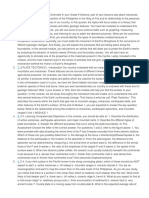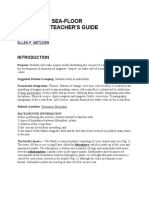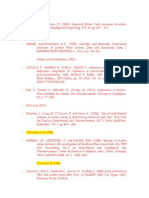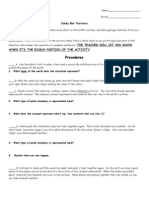Oceanography Homework
Oceanography Homework
Uploaded by
WutzdatCopyright:
Available Formats
Oceanography Homework
Oceanography Homework
Uploaded by
WutzdatOriginal Description:
Copyright
Available Formats
Share this document
Did you find this document useful?
Is this content inappropriate?
Copyright:
Available Formats
Oceanography Homework
Oceanography Homework
Uploaded by
WutzdatCopyright:
Available Formats
Oceanography
Homework Ch 3 Directions: Answer the following questions in complete sentences. Most of the information will be available in your textbook chapter. Occasionally a question will require searching on the internet or doing some simple calculations. When calculations are required, you must show your work. Type your answers as a word document, then save and upload your answer document in the assignment link before the deadline.
1) Describe the three types of plate boundaries. What processes take place at each type of boundary? In what direction do the plates move at each boundary? Divergent boundaries where new crust is created as two or more plates that pull away from one another. Convergent boundaries where crust is destroyed and recycled back into the interior of the Earth as one plate goes under another plate. Transform-fault boundaries are where two plates slide horizontally to one another usually due to plates movement from earthquakes or sliding such as the San Andreas Fault. 2) Explain the formation and symmetry of the magnetic stripes found on either side of the midocean ridge system. What is their significance when the magnetic information is correlated with the age of the crust? The mid-ocean ridge makes a divergent plate boundary and the new rocks being formed retain a magnetic orientation similar to the Earths magnetic field. Rocks that formed when the magnetic field was reversed will show a reversed orientation. This results in a zebra like pattern that is symmetrical on each side of the ridge showing they are spreading apart. They correlate to magnetic anomalies associated with outflows of lava from land based volcanoes. 3) It is unlikely that magnetic anomaly stripes older than about 200 million years will be found anywhere in the oceans. Why? Does this mean that seafloor spreading did not occur before 200 million years ago? Alfred Wehener proposed continental drift suggesting that Pangaea was one large land mass about 200 million years ago. This large landmass splintered apart into fragments which have slowly drifted away from one another to cause new ocean basins between them. It is possible that seafloor spreading occurred previous to 200 million years ago and we spread so far apart that they actually began to move toward one another eventually causing Pangaea.
4) In which ocean is the oldest oceanic crust likely to be found? Why? Looking at figure B3-3 it looks like it would be the Pacific Ocean. Age is associated with the increase in distance from the ridge crest. The greatest distance of blue shading on the map is from the crest in/near California and out into the Pacific. 5) Assume that magnetic anomaly C in Fig 3-3 is 650,000 years old. Calculate a spreading rate for the sea floor. Now, using the calculated seafloor spreading rate estimate the age of magnetic anomaly B in Figure 3-3. Speed = distance/time. So I measured C to be 4 cm from the ridge or A. Every 6 cm is 200 km so C is ~133.3km from A. Therefore, 133.3/650,000yrs = 2.05X10km/yr is the spreading rate. B is 2.5 cm or 83.3km from the ridge. So, distance/spreading rate = time or 83.3km/2.05X10km/yr 406,341.5 yrs.
You might also like
- Mechanisms of Movement Lab Report: ProblemDocument4 pagesMechanisms of Movement Lab Report: Problemno thankyouNo ratings yet
- Plate Tectonics AnswerDocument4 pagesPlate Tectonics AnswerthNo ratings yet
- Tri Ation With Real Data: NGSS Science StandardsDocument11 pagesTri Ation With Real Data: NGSS Science StandardsTHE FAJARDO0% (1)
- General Geophysics Final ExamfDocument6 pagesGeneral Geophysics Final ExamfGeremew Lamessa0% (1)
- Continental Drift Seafloor SpreadingDocument30 pagesContinental Drift Seafloor SpreadingRainier Magno100% (1)
- Practice 2nd Exam Geol 1121 Fall 2020Document13 pagesPractice 2nd Exam Geol 1121 Fall 2020owaisballer1102No ratings yet
- Q2 - Week 4 Seafloor Spreadin Lecture 1Document19 pagesQ2 - Week 4 Seafloor Spreadin Lecture 1Raian Marcus LucasNo ratings yet
- Model of Sea-Floor SpreadingDocument10 pagesModel of Sea-Floor Spreadingmaan1988No ratings yet
- Science 10 Module 1.1Document34 pagesScience 10 Module 1.1marisNo ratings yet
- Plate Boundaries and Their TypesDocument22 pagesPlate Boundaries and Their TypesAwais LeghariNo ratings yet
- Earth Science - M04 - L03 - Q2 - W3Document4 pagesEarth Science - M04 - L03 - Q2 - W3Ji PaoNo ratings yet
- Lars Vanheuverzwyn - #6 - SEA-FLOOR SPREADING WORKSHEETDocument9 pagesLars Vanheuverzwyn - #6 - SEA-FLOOR SPREADING WORKSHEETLars vanheuverzwyn100% (1)
- Continental Drift and Plate TectonicsDocument6 pagesContinental Drift and Plate TectonicssaikumarreddyNo ratings yet
- Institution of Oceanography, La Jolla, California 92037Document23 pagesInstitution of Oceanography, La Jolla, California 92037Clinton DanielNo ratings yet
- Tektonik LempengDocument69 pagesTektonik LempengAcon YusufNo ratings yet
- 2 Ocean Basins and Plate Tectonics AMS 2018Document10 pages2 Ocean Basins and Plate Tectonics AMS 2018Brandon PraterNo ratings yet
- Key Concept Review (Answers To In-Text "Concept Checks")Document3 pagesKey Concept Review (Answers To In-Text "Concept Checks")serkansancakNo ratings yet
- REVIEWER-IN-SCIENCE-10 1st QuarterDocument5 pagesREVIEWER-IN-SCIENCE-10 1st QuarterParkkimcho LeesongNo ratings yet
- ES104 2008 1029 PlateMotionDocument5 pagesES104 2008 1029 PlateMotionCarl AnthonyNo ratings yet
- Assignment CHP 1-4Document20 pagesAssignment CHP 1-4Geology for BeginnersNo ratings yet
- 1 UNIT 1 Earth and SpaceDocument19 pages1 UNIT 1 Earth and SpacevisitacionNo ratings yet
- Sea Floor SpreadingDocument4 pagesSea Floor SpreadingSumeer KhoslaNo ratings yet
- Chap 2Document14 pagesChap 2Serkan SancakNo ratings yet
- Distribution of Oceans and ContinentsDocument6 pagesDistribution of Oceans and ContinentsXyzxyzNo ratings yet
- Science Discussion NotesDocument4 pagesScience Discussion NotesIvan TroyNo ratings yet
- Anderson SeismicTomography 1984Document13 pagesAnderson SeismicTomography 1984Janaína Anjos MeloNo ratings yet
- EAS 1600 Lab 08 Fall 2018 "Plate Tectonics" ObjectivesDocument20 pagesEAS 1600 Lab 08 Fall 2018 "Plate Tectonics" ObjectivessamNo ratings yet
- Grade 10 1st QuarterDocument19 pagesGrade 10 1st QuarterxoxkakidoxoxNo ratings yet
- For Mass Production - DISTRICT ACHIEVEMENT TEST - EditedDocument13 pagesFor Mass Production - DISTRICT ACHIEVEMENT TEST - EditedCherry CaspeNo ratings yet
- Plate Tectonics Week 1Document56 pagesPlate Tectonics Week 1liza rimpaNo ratings yet
- Lab Activity 7 Plate TectonicsDocument10 pagesLab Activity 7 Plate TectonicskleinkeaNo ratings yet
- Impact of Geographical Phenomena - Form 6Document139 pagesImpact of Geographical Phenomena - Form 6Conrod Wayne Smith100% (1)
- Landforms and Landscape ProcessesDocument15 pagesLandforms and Landscape Processeschimutsotsojames1No ratings yet
- Science 4.3 Theory of Plate TectonicsDocument16 pagesScience 4.3 Theory of Plate TectonicsRazel TercinoNo ratings yet
- Engineering Geology For Civil Engineers-17-32Document16 pagesEngineering Geology For Civil Engineers-17-32Marnoel MalapitanNo ratings yet
- Paleomagnetism See Floor Spreading Convectional CurrentsDocument3 pagesPaleomagnetism See Floor Spreading Convectional CurrentsVishal chaudharyNo ratings yet
- Solution Manual For Environmental Geology An Earth Systems Approach 2nd Edition by Merritts Menking DeWet ISBN 1429237430 9781429237437Document36 pagesSolution Manual For Environmental Geology An Earth Systems Approach 2nd Edition by Merritts Menking DeWet ISBN 1429237430 9781429237437stevenedwardsgjfdctxork100% (39)
- Triassic FossilsDocument14 pagesTriassic FossilsRachelle Ann BaldonadeNo ratings yet
- Lecture Notes For Week 2 - General Geology PDFDocument35 pagesLecture Notes For Week 2 - General Geology PDFRuby LenNo ratings yet
- A Model of SeaDocument21 pagesA Model of Searajan08ismNo ratings yet
- Q2-Earth Science For STEM-WEEK6Document3 pagesQ2-Earth Science For STEM-WEEK6queancy euleNo ratings yet
- 2b. Plate Tectonic: Dr. Ir. Eko Widianto, MT Lecturer of Trisakti University JakartaDocument62 pages2b. Plate Tectonic: Dr. Ir. Eko Widianto, MT Lecturer of Trisakti University Jakartadina mutia sariNo ratings yet
- Earth Science For STEM: Quarter 2 - Module 6: Seafloor SpreadingDocument7 pagesEarth Science For STEM: Quarter 2 - Module 6: Seafloor SpreadingCheena Francesca LucianoNo ratings yet
- 060. Tectonic Geomorphology Feedbook - 2022-12-06Document19 pages060. Tectonic Geomorphology Feedbook - 2022-12-06hmkyunbatyeinNo ratings yet
- Download full Earth System 3rd Edition Kump Solutions Manual all chaptersDocument46 pagesDownload full Earth System 3rd Edition Kump Solutions Manual all chapterskwabohumeza100% (2)
- LP-G10 Processes and Types of BoundariesDocument4 pagesLP-G10 Processes and Types of BoundariesJohnie Rey VillaruzNo ratings yet
- Tectonic PlatesDocument17 pagesTectonic PlatesMaria Isabel LunaNo ratings yet
- Plate TectonicsDocument32 pagesPlate TectonicsJelly Been100% (1)
- Pratt David - Mysteries of The Inner EarthDocument90 pagesPratt David - Mysteries of The Inner Earthaivlys enialpalNo ratings yet
- Global Geological HazardsDocument27 pagesGlobal Geological HazardssalmanNo ratings yet
- Martian Layered Fluvial Deposits: Implications For Noachian Climate ScenariosDocument4 pagesMartian Layered Fluvial Deposits: Implications For Noachian Climate Scenariosjogger_VJNo ratings yet
- 3 Internal StructureDocument5 pages3 Internal StructureDavid SimangunsongNo ratings yet
- 02 - Chapt 3 Plate Tectonics v1Document73 pages02 - Chapt 3 Plate Tectonics v1anythingonthisNo ratings yet
- Tonye Geo Assignmt 1-1Document32 pagesTonye Geo Assignmt 1-1Donald Oseghale OkohNo ratings yet
- LAS Science 10 Week 8Document9 pagesLAS Science 10 Week 8Alfred QuintoNo ratings yet
- Plate Tectonics Sci Q1 G10Document27 pagesPlate Tectonics Sci Q1 G10Charlotte Anne FelicianoNo ratings yet
- Geo DPQ 3Document11 pagesGeo DPQ 3annalaanvithaNo ratings yet
- Find The EpicenterDocument14 pagesFind The EpicenterSam V.No ratings yet
- 4 Plate Tectonics KDDocument16 pages4 Plate Tectonics KDStephen Richard Kirkley100% (1)
- Plate TectonicsDocument26 pagesPlate Tectonicsshahd slimNo ratings yet
- On the Origin of Continents and Oceans: Book 2: The Earths Rock RecordFrom EverandOn the Origin of Continents and Oceans: Book 2: The Earths Rock RecordNo ratings yet
- The Ground Is Shaking! What Happens During An Earthquake? Geology for Beginners| Children's Geology BooksFrom EverandThe Ground Is Shaking! What Happens During An Earthquake? Geology for Beginners| Children's Geology BooksNo ratings yet
- Why Do Tectonic Plates Crash and Slip? Geology Book for Kids | Children's Earth Sciences BooksFrom EverandWhy Do Tectonic Plates Crash and Slip? Geology Book for Kids | Children's Earth Sciences BooksNo ratings yet
- S2 2023 476363 BibliographyDocument5 pagesS2 2023 476363 BibliographyAntonius SatrioNo ratings yet
- KMA Geophysicalstudy Papadopoulos Higgins SmithDocument1 pageKMA Geophysicalstudy Papadopoulos Higgins SmithDrift KingNo ratings yet
- GSS614 - CHAPTER 5 - TidesDocument8 pagesGSS614 - CHAPTER 5 - TidesMuhdFikriNo ratings yet
- Worksheet EarthquakeDocument4 pagesWorksheet EarthquakeRomulo Jr. AbanNo ratings yet
- California Seismic Hazard MapReportDocument65 pagesCalifornia Seismic Hazard MapReportnotavalidemail1952No ratings yet
- Topographic Map of WardaDocument1 pageTopographic Map of WardaHistoricalMapsNo ratings yet
- Construction Foundation (WWW - Sonanote.blogspot - Com) PDFDocument143 pagesConstruction Foundation (WWW - Sonanote.blogspot - Com) PDFMakaraSoyNo ratings yet
- Q2 M3 Seismic Waves GNVHS FinalDocument19 pagesQ2 M3 Seismic Waves GNVHS FinalMONICA SILAPANNo ratings yet
- Geomorphology BookDocument213 pagesGeomorphology BookDeepak KumarNo ratings yet
- IGRF13coeffs XDocument12 pagesIGRF13coeffs Xmohammad khosravipoorNo ratings yet
- Science - Grade 10: Active Volcanoes in The WorldDocument16 pagesScience - Grade 10: Active Volcanoes in The Worldmyra neri100% (1)
- Plate Movement HawaiiDocument3 pagesPlate Movement HawaiiJohn OsborneNo ratings yet
- Topographic Map of Missouri CityDocument1 pageTopographic Map of Missouri CityHistoricalMapsNo ratings yet
- COTDocument3 pagesCOTMykelCañete100% (2)
- Sci 10-Q1-Act. 12-13Document3 pagesSci 10-Q1-Act. 12-13lavenia acdalNo ratings yet
- Resistivity 1D Forward ModellingDocument51 pagesResistivity 1D Forward ModellingRohit kumarNo ratings yet
- Surface Wave ReferencesDocument6 pagesSurface Wave Referencesammar303100% (1)
- Branches of GeologyDocument23 pagesBranches of GeologyRehan Hakro100% (2)
- Plate Boundaries: Science 10 Module 2-Lesson 1Document34 pagesPlate Boundaries: Science 10 Module 2-Lesson 1sam cadleyNo ratings yet
- Earthquake: Volcanic Earthquake Tectonic EarthquakeDocument2 pagesEarthquake: Volcanic Earthquake Tectonic EarthquakeALF SamaNo ratings yet
- Palmer.05.Digital Processing of Shallow Seismic Refraction Data PDFDocument18 pagesPalmer.05.Digital Processing of Shallow Seismic Refraction Data PDFAirNo ratings yet
- Rapp - Geom - Geod - Vol - II - Rev PDFDocument225 pagesRapp - Geom - Geod - Vol - II - Rev PDFFelipe Carvajal RodríguezNo ratings yet
- Science 10 Q1 Module 2Document11 pagesScience 10 Q1 Module 2Christopher Jorge BarredoNo ratings yet
- Eurocontrol WGS 84Document122 pagesEurocontrol WGS 84SugatoSoumiNo ratings yet
- Earthquake Resistant Buildings DesignDocument2 pagesEarthquake Resistant Buildings Designhala0120% (1)
- Baseline Processing Report (Example)Document44 pagesBaseline Processing Report (Example)Andrei AndreiuTzNo ratings yet
- Candy Bar TectonicsDocument2 pagesCandy Bar Tectonicspandrea112285No ratings yet

























































































